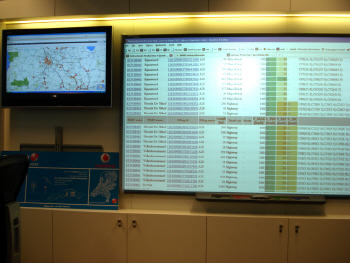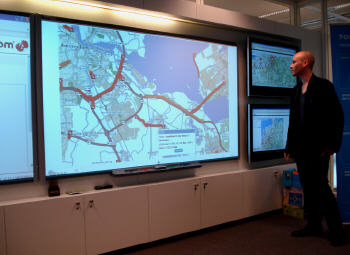Reducing traffic congestion for everyone is a lofty goal. Nonetheless, it is the stated goal of TomTom in its Traffic Manifesto, launched on October 20th. The company hopes to reduce journey times by 5% whether drivers are using TomTom's personal navigation devices (PNDs) or not. The company believes that it is already improving travel times for its drivers by 15%. But there's more. When even 10% of its users adopt TomTom's HD (high definition) Traffic navigation system the company believes that there will be a "collective effect" for all drivers, further improving travel times for everyone. TomTom's HD Traffic is a combination of its traffic information, which the company believes is superior to its competition, combined with its dynamic route guidance system, which will be explained below.
TomTom has seen better days financially; its most recent quarterly report informed stockholders of a 37% decline in net income versus 2009. TomTom blamed the result "firstly by the U.S. dollar being, on average, stronger compared to the euro, secondly by the deferral of high margin revenue linked to services on our PNDs and thirdly by changes in product and regional mix," according to TomTom's press release. By contrast, NAVTEQ recently reported a net sales increase of 52% year over year. So, TomTom is feeling the pressure to stake a position in the market where it feels it can win.
The Traffic Manifesto appears to be an attempt to claim a leadership role in one segment of the navigation market. It has the appeal of reducing headaches that drivers in large cities commonly confront. The company's effort to encourage everyone to use PNDs for driving also works to enhance its "green" reputation. The added twist is that drivers can experience an even greater reduction in traveling times if they use TomTom's HD Traffic.
What is HD Traffic? According to TomTom, "High Definition Traffic technology is an advanced service for TomTom end users that delivers up-to-the-minute, detailed incident reports about the length and reason for delays, the most accurate delay information, travel and arrival times and alternative route proposals." HD Traffic is available now on many TomTom PND products.
A visit to the company's traffic management center in Amsterdam yields an informative look at TomTom's HD Traffic. At the center, TomTom monitors input from multiple sources (Figure 1). These sources include its customers' connected devices (such as cell phones, designated by the letter "C" in the graphic, far right column) and PNDs (those who have elected to share their information), and roadway sensors provided by government sources (designated by the letter "G" far right column). TomTom's traffic algorithm compares posted speeds with actual roadway speeds and determines whether an incident such as a car accident has occurred. TomTom may relay that information to drivers' devices to calculate alternative routes. This information is constantly being analyzed for many cities around the world (Figure 2) and users receive an update every two minutes. HD Traffic factors historical data into these calculations as well, so the suggestion of an alternative route may be based on time of day, as well as any events that could impact traffic. As with many traffic information systems, roadway line segments change color to indicate current traffic conditions.
 |
 |
So where does TomTom take this "manifesto" and can it succeed? It's an interesting strategy to find a niche in the navigation marketplace that may wedge some distance between itself and its competitor, NAVTEQ, whose parent company, Nokia, has such a stronghold on the European mobile phone market. Everyone who faces major traffic congestion on a daily basis can certainly identify with the challenge. If TomTom can become synonymous with solving traffic congestion, the strategy stakes a position in the mind of drivers looking for their next PND.
TomTom's future plans call for annual traffic summits bringing the best minds in the industry to help solve the problem, and working with governments to advise them on urban development and transportation routing. The company is looking to partner with environmental groups to explore ways to reduce carbon emissions. It's a bold plan that may lead TomTom toward greater profitability.